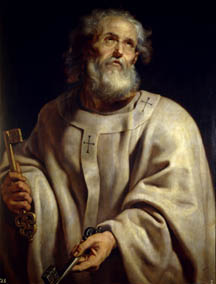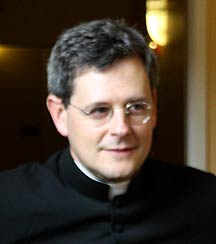A Letter from the Superior General Fr. John Berg, FSSP
 This month of June closes with the great feast of Saints Peter and Paul on the 29th. Those who have visited Rome know firsthand the importance to the Eternal City of these two great martyrs. Because the rite we celebrate is truly Roman, this feast has also always held a particular pride of place in the liturgical calendar.
This month of June closes with the great feast of Saints Peter and Paul on the 29th. Those who have visited Rome know firsthand the importance to the Eternal City of these two great martyrs. Because the rite we celebrate is truly Roman, this feast has also always held a particular pride of place in the liturgical calendar.
It is, of course, also the principle feast of our Fraternity of St. Peter, and we have considered ourselves fortunate to have such a great intercessor and example in the Prince of the Apostles. The choice of taking on the title of St. Peter for our institute was really a rather audacious one. Just as no Pope has dared to take the name Peter II for two millennia, so too, no institute or religious order has taken the title of the one chosen to be the first Vicar of Christ. But given the circumstances of our inception, our founders were encouraged to choose as our patron the one upon whom Christ chose to build His Church.
In our coat of arms (as found at the top of this page), upon the blue field which invokes the Blessed Virgin Mary are placed two symbols of St. Peter. The most recognizable are the keys which we are accustomed to seeing in the hands of almost every depiction of the Prince of the Apostles.
For our Fraternity they represent our particular attachment to the See of Peter, upon whom rests the authority to bind and to loosen: “And I will give to thee the keys of the kingdom of heaven. And whatsoever thou shalt bind upon earth, it shall be bound also in heaven: and whatsoever thou shalt loose on earth, it shall be loosed also in heaven” (Mt. 16:19).
 An important aspect of our work is the formation of men for the priesthood who are prepared to combat error with truth. To do so requires a well-formed intellect to recognize what is dangerous to souls striving to walk along the straight and narrow path towards heaven. For example, if you come from a cold climate, you know that it is not wise to say that it is the springtime when it is really the winter. A mother who would say this to her children would put them at risk, as they would go out without being properly dressed for the elements.
An important aspect of our work is the formation of men for the priesthood who are prepared to combat error with truth. To do so requires a well-formed intellect to recognize what is dangerous to souls striving to walk along the straight and narrow path towards heaven. For example, if you come from a cold climate, you know that it is not wise to say that it is the springtime when it is really the winter. A mother who would say this to her children would put them at risk, as they would go out without being properly dressed for the elements.
Oftentimes, the battle against error accompanies suffering with the Church as she suffers.
The second symbol on our coat of arms is the three tears which represent the triple confession of contrition of Simon Peter when our Lord asks him if he loves Him, following his denial of Christ (Jn. 21:15-17). These three tears are principally intended to remind our members of the deep love of St. Peter for Christ; and that, despite his weaknesses, he had the charity and humility to carry out the difficult task entrusted to him by our Lord to “confirm thy brethren” (Lk. 22:32).
These tears are also meant to signify the fact that the Fraternity was born at a moment of difficulties and sorrows within the Church: “They that sow in tears shall reap in joy. Going they went and wept, casting their seeds. But coming they shall come with joyfulness, carrying their sheaves” (Ps. 126:1-5).
But they could just as well be tears for the state of the world in which we live, where man’s positive law seems to move daily further and further away from God’s Natural Law. The present Administration’s so-called “HHS Mandate” is perhaps the most frightening example yet in that not only are the most heinous crimes allowed in the name of “choice” by the state, but now it wishes to force everyone to participate in these acts in some manner.
 In the face of such “mandates” from the state—which would have seemed unimaginable just a few years ago—it would be easy for our hope to be shaken. Yet it is, of course, only a step in the long slippery slope of secularization in the Western world. The poet T.S. Eliot describes the perseverance necessary in such a state: “The World is trying to experiment with attempting to form a civilized but non-Christian mentality. The experiment will fail; but we must be very patient in awaiting its collapse; meanwhile redeeming the time: so that the Faith may be preserved alive through the dark ages before us; to renew and rebuild civilization, and save the World from suicide” (Thoughts After Lambeth, 1931).
In the face of such “mandates” from the state—which would have seemed unimaginable just a few years ago—it would be easy for our hope to be shaken. Yet it is, of course, only a step in the long slippery slope of secularization in the Western world. The poet T.S. Eliot describes the perseverance necessary in such a state: “The World is trying to experiment with attempting to form a civilized but non-Christian mentality. The experiment will fail; but we must be very patient in awaiting its collapse; meanwhile redeeming the time: so that the Faith may be preserved alive through the dark ages before us; to renew and rebuild civilization, and save the World from suicide” (Thoughts After Lambeth, 1931).
Here, too, St. Peter provides for us a great model of the perseverance and the courage of the Church: His epistles are an exhortation to his flock to concentrate upon faith and charity in the face of a world hostile to the message and moral teaching of Christianity.
The people’s faith was to be the anchor of their daily lives in the midst of tribulations: “Wherein you shall greatly rejoice, if for now you must be for a little time made sorrowful in divers temptations. That the trial of your faith (much more precious than gold which is tried by the fire) may be found unto praise and glory…” (I Pet. 1:6,7).
Their charity was to be seen in all aspects of their lives in offering up wrongs done to them in imitation of our Lord: “For this is thankworthy: if for conscience towards God, a man endure sorrows, suffering wrongfully” (I Pet. 2:19). Charity was further to be lived out by showing a worthy example in society to those who did not believe: “Having your conversation good among the Gentiles: that whereas they speak against you as evildoers, they may, by the good works which they shall behold in you, glorify God in the day of visitation” (I Pet. 2:12).
 But our patron St. Peter did not stop simply with words and exhortations. He also set an example—which would serve so many of his successors as the Vicar of Christ—as to how to live this out unto martyrdom. May St. Peter, our great patron, intercede for each of us to have the courage and perseverance of the early Christian martyrs in the face of this world in which we live!
But our patron St. Peter did not stop simply with words and exhortations. He also set an example—which would serve so many of his successors as the Vicar of Christ—as to how to live this out unto martyrdom. May St. Peter, our great patron, intercede for each of us to have the courage and perseverance of the early Christian martyrs in the face of this world in which we live!
Yours in Christ,

Fr. John Berg, FSSP
General Superior of The Priestly Fraternity of Saint Peter
June 26, 2012








